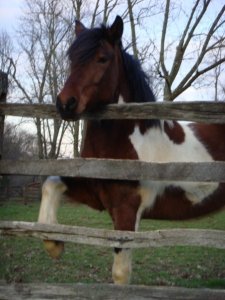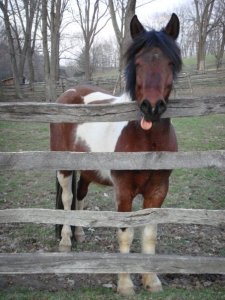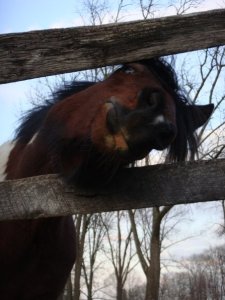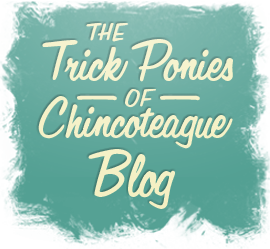Posts Tagged ‘pony
It Makes Mouths Happy
The bit is the cause of over 100 harmful effects. First and foremost, a bit is painful and it frightens a horse. It makes it difficult for a horse to be happy in its work and for a rider to achieve that harmony so essential to a partnership. It also makes it difficult for a horse to breathe, stride, perform, and stay healthy.

A common mis-conception is that you cannot get your horse "round" while using the bitless bridle
This quote is taken from the Bitless Bridle Website – a revolutionary new bridle that I just began using on the newest pony in my herd, Chesapeake Boomerang aka Boomer. Before discovering this bridle (and before I bought Boomer) I had been using mostly a hackamore bridle on Minnow (which rarely was actually engaged on him because I taught Minnow to respond to seat and leg pressure for guidance). I do admit though that in competition with Minnow I would put him in a kimberwick bit for added security as the excitement of racing sometimes overpowered him and I liked to have a little extra control. If I had known of the other alternatives then I would have tried them.

Boomer the day I bought him - before the bitless bridle
However, that was the past – onto the future – and the Bitless Bridle. When Boomer came to live with me he arrived with a snaffle bit. From the very first day that I tried him he was difficult to bridle, he would clench his teeth tight and raise his head to evade it. Although once the bit was in-place he had a very soft mouth and was quite responsive. At first I thought it was his teeth, being 5 years old he hadn’t had them floated yet. But upon having them done the issue was still present. As I continued on my path of training Boomer he began to develop a bucking problem. When I purchased him I was aware that he was known to buck on occasion – so it was nothing totally new. But this buck a little different, it started off small and then gradually progressed to a full blown bronco buck. I’m talking all four feet off the ground, intent to dump me, wild pony buck! Its amazing he never threw me! It usually happened out on the trail, brought on by excitement and adrenaline. As I began working with a local trainer to fix the issue it became evident that the real source was the bit. I discovered that when something excited Boomer (sometimes it was fear, sometimes joy at the activity at hand) he actually tested me for rein pressure. He would bump his mouth up against the bit and if he felt the slightest bit of rein pressure on his mouth he would use this as a reason to take off bucking. So now that I had the issue diagnosed, it was time to do something about it, my pony obviously had an issue with the bit.
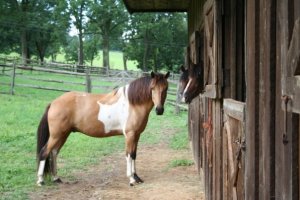
Chesapeake Boomerang at home with Blitz and Minnow
My first solution was to begin working more focused on riding him with the use of my legs and seat only. Much in the same way I started with Minnow, I began teaching Boomer to move off from my leg, stop with the shift of my hips and so on (I think this is important in the training of any horse, not just ones that have “issues” with something). He progressed rather well, but we still have a long way to go. The next step was to actually throw away my reins when Boomer began his “rein testing” before a buck. Now this is no easy task, natural human reaction to your horse on the verge of a buck is to grip onto your reins for dear life. But I succeeded in forcing myself to grab the pummel of my saddle instead of my reins – and it began working (I did feel like I was becoming some sort of rodeo rider though, haha). Boomer would begin his rein test, and when he felt no pressure at all he would immediately relax. But what I didn’t anticipate was that in his relaxation – being a pony- he would dart for any blade of grass the appeared in site. Leg pressure alone would never get my “poor starving Chincoteague Pony” to lift his head – so alas the implement of some rein pressure was needed again – and wouldn’t you know that would just send him right back into his bucking again. Ok, so new plan – now I had him in a hackamore while still trying to use no rein pressure. I saw some improvement, but instead of the buck I now had a head toss – I was willing to take that until I was able to fully train him to my seat and leg aids – but I was having extreme difficulty with still not being able to pull my ponies head up from the grass when the only area I had to work with currently was a grassy field.
While at a horse expo last month I came across a booth for the Bitless Bridle. I debated whether or not it would be helpful, but decided to give it a try. It turned out to be such a success, Boomer is no longer bucking, I can put some rein pressure on him if needed without the issue of explosive behavior, and we are have a much “happier” ride together. I am still continuing to train Boomer to respond to seat and leg pressure – and I am by no means advocating that just switching to a Bitless Bridle is the quick fix to all issues (all horses need proper training) – but I am saying that I think it is a successful training aid that “makes mouths happy”. I think from now on I will continue to use only a Bitless Bridle on all of my horses. I’m slowly converting the rest of my family, and our horses seem much happier with the switch. In the end thats all thats important, making the “work” enjoyable for your horse.
Food for Thought
I find sometimes that the “horse community” looks down on trainers that use treats to reward their horses. I think that the main resistance to this is that most people think that their horses will get grabby (which is definitely true if its not done properly) and that if they were to use treats in training it would become a crutch and they would always have to use treats from then on. These common mis-conceptions are valid, but most people that believe this are uneducated in reward-based training.
I found a video that addresses “horse mugging” when using clicker training.
I have had to address the “horse mugging” issue with all of my ponies. Being that they are ponies they can get grabby about the food, which if not addressed could lead to dangerous situations of your horse nipping at people for food. When I first began clicker training Minnow I noticed as we progressed he began to get a little grabby, he started pulling at my clothing in an effort to get his reward faster. To stop this unwanted behavior I placed him in a stall with a stall guard up. I stood on the other side with a large juicy apple in my hand. I would place the apple just in reach of Minnow’s mouth, but I would not “offer” it to him. (I consider offering to be placing my flat open palm right under his mouth.) Everytime Minnow grabbed at the apple without being offered it I closed my hand and pulled it away from him. When he did something other than grabbing at the apple (for him he began turning his head to the side – I have found that some horses “collect” themselves instead) he would then get a click and would be “offered” a different treat. It didn’t take long before Minnow realized he had to be offered his reward or else he wouldn’t get anything (I love my smart pony).
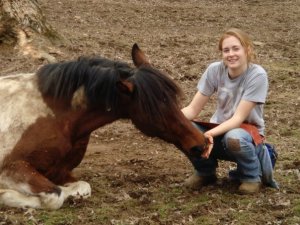
Blitz being "offered" a reward for laying down
And as far as being dependent on the treats – I think Minnow proves that you do not always need the reward to get the performance. I clicker trained him to be an exceptional mounted games pony – and not once during competition did I ever need to reward him (aside from a pat and a “good boy”). He worked and performed for me because I have made learning enjoyable for him. He doesn’t need his “treat” all of the time, but the fact that he knows it may be coming makes him work that much harder. Once I have my ponies trained for a specific skill I for the most part eliminate the treats as well as the clicker. They learn to work off my voice commands and cues – and they are happy for the occasional treat I may offer. I believe the reward-based horse training methods are one of the best out there because they tap into the horse’s number 1 focus in life – food. These methods may not be for everyone, and I’m not trying to convert everyone I meet or anything, all I’m saying is it works for me and my horses. I think any method that humanely helps you reach your goals with your horse is a success, afterall aren’t we all striving for the same thing – a partnership with our animals? I know I am.
-KD
Slow down, you move to fast
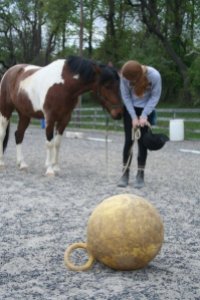
Taking small steps to get Blitz to target the ball when he first came to live with me. May 2008
I just read a great article on a Parelli Blog about moving too quickly for your horse. You can read the article HERE. I don’t really follow the Parelli method, but I think as trainers we can take inspiration from any and everything. This article really touches on what I was talking about yesterday in my “to observe” post. We all want everything done RIGHT NOW (hence why fast food came about), but the fact is our horse may not be ready for “our right now”. We need to learn to take cues from our horses about whether or not we are moving too quickly for them. Horses are smart but they aren’t mind readers, just because we think what we are asking them is so simple doesn’t mean they understand. One of my favorite trainers always says to me “ride for tomorrow” meaning ride and train your horse for what you want it to be tomorrow not today – more simply put, don’t rush it. You will have a better animal if you take simple steps to get to your bigger goal.
-KD
The Most Beautiful Chincoteague
Last night I went out after work to feed the horses. It was such a nice night (despite being somewhat cold) that I took some time to work with Minnow. We practiced “drinking out of a bottle” and I even began worked on the beginning steps to having Minnow stand on his pedestal with all 4 feet. I took some videos that I fully intended to post this morning – that is until Blitz happened!
Blitz or Chesapeake Lightning was purchased by me last May and several months later I ended up selling him to my Mom. I still consider him “one of my own” even if I don’t technically own him. Now when I say “Blitz Happened” I mean he pretty much stole me away from Minnow with his quirky antics and his beautiful face. That beautiful face of his is what made me buy him in the first place. As soon as I saw him I fell inlove instantly – something about him is just memorizing, and I’ve never had a horse quite like him. I think he thinks he’s human. Just see for yourself……
To observe
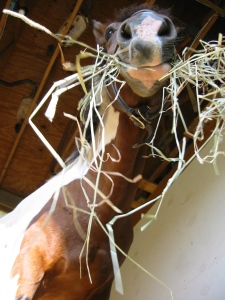
Observing Minnow 2005
We all do it. In today’s society everyone wants everything done right away, we all have goals, and things we need to get done. Working with our horses is no exception. We need our horse to master that square halt for the dressage test, we need him to jump the scary ditch, and on and on. Everyone is guilty of it, including myself, its human nature to have a “plan” and something to work towards, its what gets us up in the morning.
Horses are different though, what gets them up in the morning is #1 food – and the need to “accomplish” something is very far down their list. So what I’m getting at is why do we always “need” something from our horses? Have you ever sat and observed your horse? Just showed up at the barn with no plan and simply sat in the field and watched your horse. Most people haven’t, however most of us have observed our dogs. Yes I have plans for my dogs, I like them to obey, go to the bathroom outside (etc.), but I also enjoy just sitting on the couch with my dachshund and watching tv. In that time I spend with him I’m not asking him for anything and he’s not asking me for anything, we are simply just being together. Maybe we don’t do it with horses because we see dogs as more human simply because they live in our homes with us (although I can’t lie that it hasn’t crossed my mind to have Minnow living in my home with me).
I didn’t realize the importance of not “wanting” something from my horse until I took Minnow to college with me in 2005. I
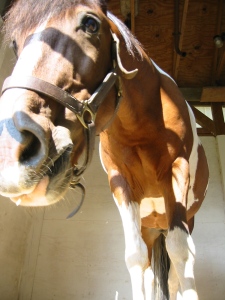
was lucky enough to be able to board him at a friend’s family farm, so the majority of the time I had the place all to myself. And the days I got to go out to the barn (which was pretty much everyday) was such a treat for me. Spending the day in class was exhausting, so when I got to see Minnow at the end of the day it was the most wonderful feeling. Many days I would just collect all of my books and Minnow, head out to a big grassy field and while he stuffed his face I laid on the ground by his side and studied. It was during these times that I began to notice a change in Minnow. For a pony who lived in a dirt paddock with hardly any grass (and whom I already knew had a total love for food) he spent a lot of his time during these “outings” sniffing my books, nuzzling my hair, kissing my face.
This made me realize something, to Minnow I had always been this “being” that showed up and demanded things from him . Now suddenly I didn’t want anything – and I was giving him something he wanted – food! I began spending more and more time just enjoying and observing Minnow – on rainy days I would park myself in his stall on a pile of hay. As these sessions continued Minnow began to become much more interested with me. He was the first one to the gate when I came to feed, and he began looking to me for guidance…as if to ask “what would you like me to do now?”.
Since our “college” days I continue to practice observing my horses – I try not to always ask things of them. I not only sit in their stalls and pastures with them, but I take them on walks (where our sole purpose is to find the greenest patch of grass) and we take trips to the lake where I let them swim. Because I take the time to observe my horses when I come to feed (my ponies currently live outside with a big shed) they come barreling down the hill to their assigned buckets at first sight of me. They stand patiently for their food and when finished they don’t run off, instead they mingle around the shed waiting to be brushed – brushing your horse can even be seen as “needing something” – do you ever brush your horse when you don’t intend to ride or do anything with him? I even tack my horses up in the shed, unhaltered and untied. And the amazing part is not once do I have the need to chase my ponies around the field, not even when I break out the muzzles! Yes the pony muzzles, those dreaded things! They don’t know its for their own good (to avoid the horrible consequence of too much grass called founder) but they willingly put their faces into the muzzles without me having to hide it from them, or chase them around the pasture. We all know that familiar scene of the person who stalks their horse out in the field with the halter behind their back trying to convince themselves and their horse that “I just want to pet you”.
So next time you go out to the barn try observing your horse, you might just learn something about them.
-KD

